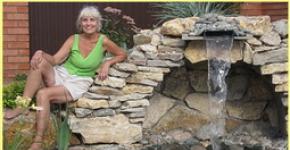How to grow a dwarf weeping birch. Weeping, dangling, warty birch
Description
Hanging birch ‘Yungi’ differs in small height and very weeping form. A small standard tree, picturesque, slow-growing, with an umbrella-shaped, weeping crown, up to 5 m high and up to 3-4 m wide, the bark is white, smooth, there are rare black cracks, shoots are flexible. Lives up to 120 years, less often to more adulthood.
Young trees can be confused with alder, because their bark is brown, and it only turns white from 8-10 years old. In adulthood, it differs well from other trees in the snow-white bark. In older trees, the bark in the lower part of the trunk becomes deeply fractured, black.
The branches are bare, covered with numerous densely friable, resinous glands, warts (hence the name came from warty birch and weeping birch). Young branches hang down to the ground, which gives the crown of a birch a very characteristic appearance of an umbrella. The crown is branched, but not dense.
The leaves are light green, smaller than that of the species plant, pointed, triangular, serrate along the edge, bloom in early spring, and in the fall acquire an inimitable yellow color. Leaves from rhombic-ovate to triangular-ovate, smooth, sticky at a young age.
Flowers are yellowish inflorescences - catkins, melliferous, flowering occurs before the leaves bloom in April - May.
Root system hanging birch ‘Yungi’ superficial, can lift pavements, is sensitive to soil compaction and planting of a near-trunk circle, the presence of drainage, is rapidly developing.
He loves the sun, it is very winter-hardy, planting is best done in spring, it is stable in industrial conditions.
Any soils, from neutral to slightly acidic, are sensitive to salinization, normally develops on alkaline.
Hanging birch ‘Yungi’ used as a tapeworm, for small gardens and household plots, the design of the coastline of reservoirs.
Landing and care
Landing Features: Dangling Birch ‘Yungi’
Planted in open places or in partial shade. Plants with decorative leaf color when planting in the shade lose their color.
Root neck at ground level.
If groundwater is close, a drainage layer consisting of crushed stone or sand 10-20 cm is poured at the bottom of the landing pit.
Soil mixture:
Sod land, peat, sand - 2: 1: 2.
Optimum Acidity - pH 6.0 - 7.5
Top dressing:
In the early spring before the appearance of leaves and in late spring - early summer, fertilizing with nitrogen-containing fertilizers:
mullein - 1 kg
urea - 10 g
ammonium nitrate - 15-20 g
In autumn, fertilizing with mineral fertilizers: nitroammofosk 15-20 g.
The drug is diluted in 10 liters of water. One plant requires 10-20 liters of solution.
Watering:
After planting - 20 liters per plant. Birch has a superficial root system, therefore it requires watering in dry periods at the rate of 10 liters per 1 sq. M of the crown projection. Young plants in the dry period require more frequent and plentiful watering, because can intercept moisture from fruit trees, shrubs and garden plants.
Loosening:
Loosening to a depth of not more than 3 cm for weed control.
Mulching:
Mulching of the trunk circle with peat, peat compost, wood chips. The thickness of the mulching layer is 8-12 cm.
Cropping:
Cutting out drying branches in the spring.
Pest Protection:
Birch sapwood
Bucephalus Corydalis
Pipe Beetle
Chafer
Silkworm nun
Shield
Disease Protection:
Rust
Preparing for the winter:
In newly planted young plants, sprinkle tree trunks with fallen leaves.
Related Content
 |
In the garden |
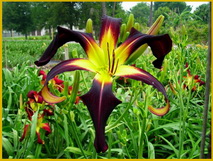 |
Perennial |
Weeping birch - the right solution for a small garden
Weeping birch is a decorative variety of ordinary birch. Its beauty lies not only in the white trunk, but also in the openwork crown, in the long thin branches that smoothly hang down.
Weeping Birch: Structural Features
Previously, this species was called warty birch. The birthplace of this species of birch is Asia and Europe. The plant is very fond of light, a young weeping birch may even die if it is not grabbed by it, but an adult tree becomes ugly. Birch can grow on almost any soil, the tree tolerates drought well.
In young birches, the bark is brownish, and from the age of nine begins to turn white.
Because of this feature, some young birches can be confused with an alder. In old trees, deep black cracks appear in the lower part of the trunk. The color of the branches is brown-red, the branches are covered with small warts, which is why this species of birch is sometimes called warty. The crown of the tree is branched, but not too thick.
The shape of the leaves is:
The flowers of the birch are small, collected in earrings-inflorescences at the tips of the branches. Birch blooms before the leaves bloom.
Variety of Weeping Birch
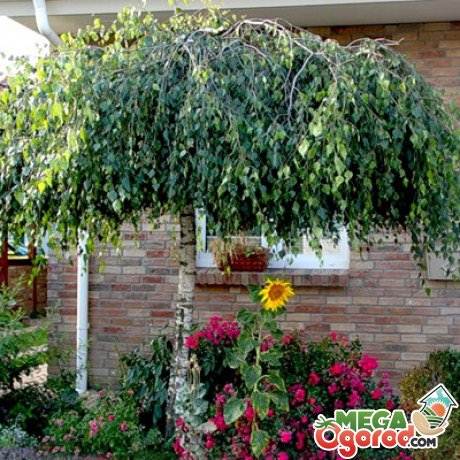
Not everyone can afford a sprawling tree, since summer cottages are usually small patches of land. It was for summer residents that agronomists developed a special kind of weeping birch - dwarf weeping birch.
One of these varieties is the Jung variety:
- This tree is growing very slowly.
- The branches of this birch very beautifully descend to the ground, and the height of the tree reaches only six meters.
- The plant does not become less beautiful from this, on the contrary, the attractiveness of the variety increases.
- For sites with a small area, such plants will be an ideal option.
- You should not plant a variety next to fruit trees, as Jung will inhibit their growth.
Reproduction and planting
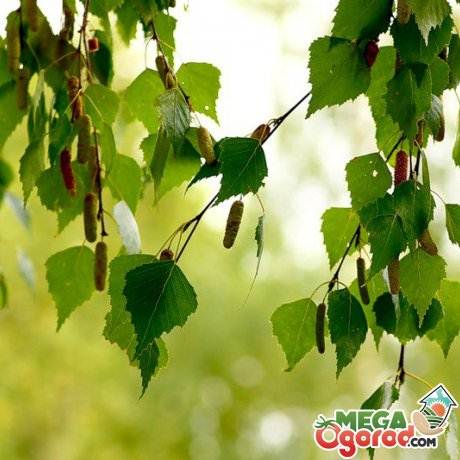
Weeping birch is propagated by seed. Sometimes trees are restored by shoots. Usually this method is applicable to young trees. Wild conditions do not imply seed propagation, as this is prevented by moss cover. In the forests, weeping birch can be restored only by shoots. In just a year, birch can recover from a stump.
Most of the trees grow from the overgrowth, but under favorable conditions, the plant can reproduce by seed.
Male flowers appear on the tips of branches. Pollen forms in spring flowers. Female flowers, similar to earrings, are shorter than male ones. In the eleventh year of life, fruits appear. In appearance, they resemble very small lentils and have two wings. Seeds appear regularly. Some fall in the fall, and some fall in the winter, so that when the snow melts, find themselves in the ground.
Seed cultivation:
- To grow a weeping variety of birch, you must first collect the seeds.
- You need to start collecting in late autumn, as the earrings begin to turn brown.
- In spring, seeds can be sown in a cool greenhouse.
- You need to store the seeds in a glass container, but remember that only a third of the seeds will sprout.
- Sprinkle the seeds with soil and lightly crush.
- Put thin branches or straw on the sowing place.
- Water only through such a layer until the first sprouts appear.
- Immediately remove the branches after emergence, clean the straw carefully, being careful not to damage the weak plants.
- Shade the seedlings with a shield.
Tree Care and Transplantation

After the seedlings have grown enough, they must be transplanted to a permanent place. It is best to transplant a tree before it reaches 7 years, because after this age it survives worse.
You need to transplant the plant in March. If the tree has become too large, then it is better to transplant it in the winter, when the ground froze to the roots. This type of birch can not even grow on fertile soil. It can be planted in any land. A wonderful option will be loose humus soil. The roots should not be bare.
During planting and care, a large amount of water is needed.
If you use fertilizers, the planting process will be much faster, and the plant will take root better. Dig a hole in the place where you plan to transplant a birch. Mix humus with sand and fill the hole with this mixture. Transplant a tree and add earth.
Be sure to water the tree for four days after transplanting. An adult weeping birch needs up to 20 liters of water per day on hot days, which is why it is worth growing this tree in fairly humid places.
Vaccination of weeping birch
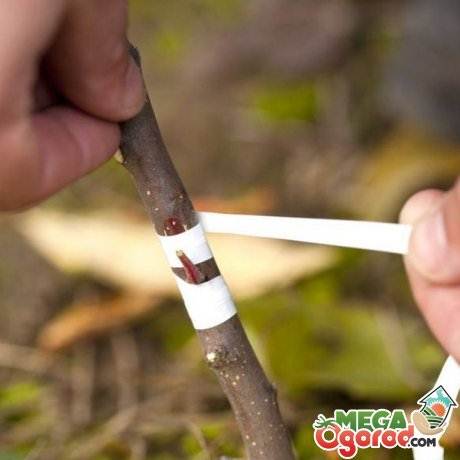
Surprisingly beautiful plants are obtained when twigs of another breed are planted. Decorative weeping birch is no exception. Cuttings of the tree can be grafted onto the most ordinary tree, eventually getting a beautiful specimen. Such plants are most often found in park areas.
Seasoned gardeners give some tips on how to plant a weeping birch:
- The shape of the crown depends only on the place where the stalk is grafted.
- Most often, grafted plants do not reach the height that happens with ordinary birches, because of this property they are often used in landscape design on small plots of land.
- Such beautiful breeds as the Yungi birch are born precisely by grafting a certain variety of branches on a regular birch. This is how the beautiful effect of a waterfall of branches is created. This technique will help create wonderful forms of birches in the garden.
If at the cottage an ordinary white birch has long been growing, then from a tree you can make a birch hanging. The tree will be very beautiful, and besides, the usable area will be reduced. Thanks to this grafting technology, willow cuttings and birch bark can be combined. Sometimes it’s possible to create very bizarre crown shapes.
There are methods, following which you can plant a willow on a birch:
- Work related to vaccination. should be performed while the juice is still moving inside the tree.
- Willow cuttings are in hibernation at this time.
- The shoot needs to be cut off, a willow stalk is attached to the tree.
- The junction of the shoot and the vaccination site must be obliged to special material, and with the onset of cold weather - to insulate.
- The branch will take root by July.
More information can be found in the video.
More information
Any summer gardener wants to add another unusual original element to his garden. An excellent solution will be weeping species of plants familiar to everyone, such as apple trees, spruce, pine and mountain ash. Or traditional types of weeping plants - willow and birch. Peculiar fountains of greenery, separately standing or in the array, will be able to decorate a country garden of any layout and style.
Weeping trees in the garden
Weeping trees that shade a flower bed or flower bed will look great in the garden. For the central part of the cottage garden, a composition of weeping trees of different heights is suitable. Their drooping crowns can create real shady alleys. Several of these trees will add extra comfort to the playground. A fabulous willow can help create a fabulous atmosphere on the plot, the branches of which will sink directly into the water of a small summer cottage. Separately standing on an even lawn, small weeping trees give the impression of interesting plant fountains. Instead of the usual lawn, a plot of land near a weeping tree can be filled with shade-loving soil protectors or moss, and plant the borders of the plot with a moisture-loving swamp iris, sedge or reed. Such an illusory pond will become a real pride of any gardener.
With the help of weeping trees you can dilute a large orchard. For these purposes, low varieties of fruit weeping trees are perfect. It can be a weeping peach, a weeping apple tree or a weeping mountain ash. Weeping mountain ash, a fragile tree with beautiful cirrus leaves, even after 10 years will look like a toy. In the spring, weeping mountain ash pleases with a large number of beautiful white flowers, in the summer, bright fruits come to replace the flowers. In autumn, the leaves of mountain ash will become a rich bogey yellow color, and clusters of orange berries will remain until winter.
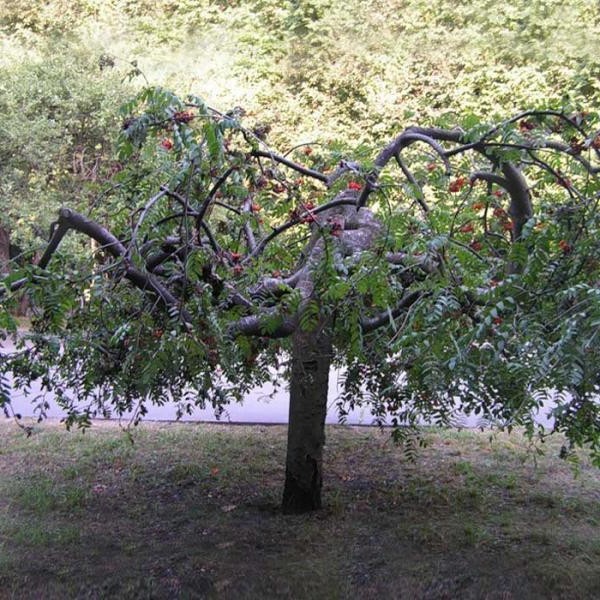
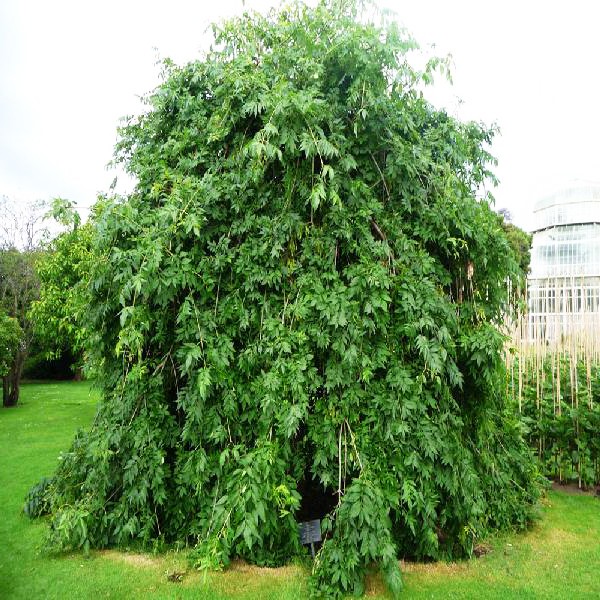
Trees of weeping form, although they are relatively small, but in a small cottage area where it is impossible to develop a large garden, even such trees will look rather bulky. However, there is no need to despair; modern breeders are constantly creating new forms of small sizes.
Weeping Tree Selection
Like ordinary trees with a normal crown shape, weeping trees have a wide variety of species and varieties. They can be matched to any layout and style of landscape design. Since some trees like to grow in the shade, others on moist soil, some are very beautiful during the flowering period, and some are completely transformed and reach their peak beauty in the fall.
Weeping willow - a weeping tree shape created by nature. It is not a very tall tree, not over 15 meters long, with long, very flexible branches. Flowering occurs in very long beautiful earrings. Such a tree is not whimsical to soils, but grows best on loam. Immediately after planting requires abundant watering. It does not tolerate the cold season, so it is advisable to shelter a tree for the winter. From the weeping willow trees beautiful alleys, pergolas and hedges are obtained.

Weeping birch, it is also commonly called warty or drooping, a tall, slender tree that can reach a height of more than 20 meters. The tree tolerates frosts and is characterized by fast growth rates. He loves open sunny places, unpretentious to soils.
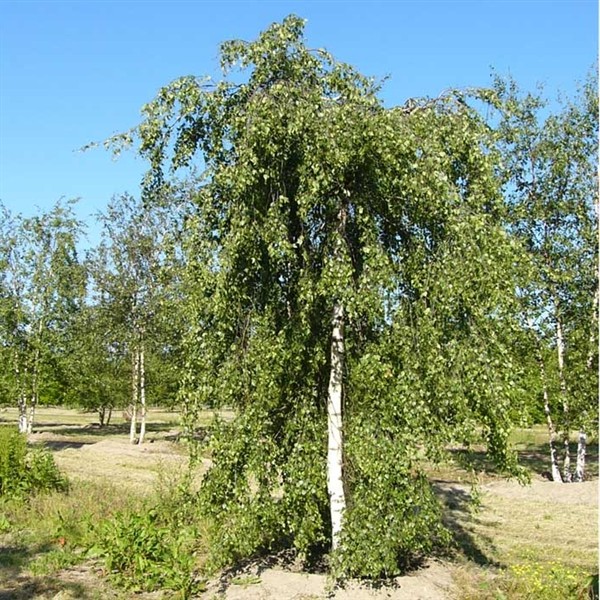
Weeping ash is a low tree. Ash rarely exceeds 8 meters in height. Prefers soils with a high calcium content, likes light areas. The most beneficial weeping ash looks in single plantings.
Acacia weeping - a very hardy tree, reaching a height of not more than two 2 meters. Shade resistant, tolerates severe droughts and frosts, can grow on any soil. In spring it blooms with beautiful yellow inflorescences; in the summer, the foliage of the tree acquires a rich green color.
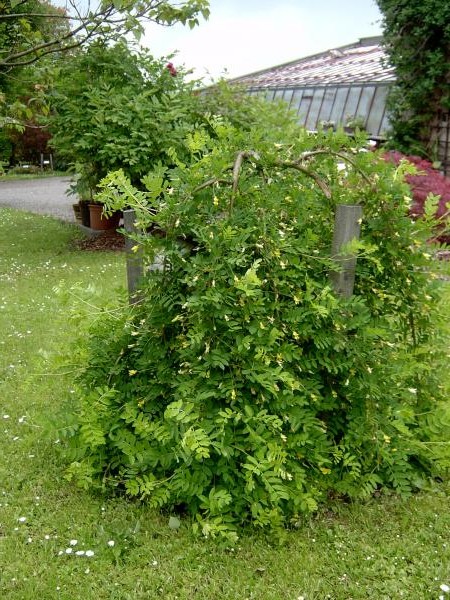
Increasingly, gardeners in their plots plant various conifers with a weeping crown shape.
Weeping pine. The most popular are three types of weeping pine: weymouth, black and yellow. All these types of pine are photophilous, tolerate frost and drought, can grow on any soil. They are distinguished by a thick falling crown, which will not lose its beauty even in the winter period of time.
In the mountains, this birch rises to a height of 2100-2500 m above sea level. Introduced throughout the temperate zone.
|
Alternative names for white birch at the end of the 19th century in various regions of the Russian Empire according to the Brockhaus and Efron Encyclopedic Dictionary |
|
| Region | Title Options |
|---|---|
| Arkhangelsk province | chistyak |
| Vologda province | bullshit, purge |
It is undemanding to the external environment and can grow in a wide variety of conditions, but does not tolerate intense heat and the proximity of groundwater (in wetlands it is replaced by a close species - fluffy birch ( Betula pubescens Ehrh.) It plays an important role in the conservation of forests after fires and deforestation of coniferous forests. Small winged nuts of a birch sag are carried by the wind over long distances. She quickly develops the vacated areas, and under its canopy, native wood species are restored.
The most productive dangling birch forests grow on sandy loam and light loam lined with carbonate soils. The wood stock in them is 100-200 m³ / ha.
Economic value and application
Dry distillation from birch bark get tar. Previously, he went mainly to lubricate the wheels of carts and carriages, as well as to impregnate leather shoes.
Birch buds are used in the manufacture of creams and other cosmetics. Essential oil from birch buds is used in the distillery industry.
Leaves, less often the bark used to be used for dyeing wool and fabrics.
Medical use
Buds and leaves are used in folk and scientific medicine, they have diuretic, choleretic, diaphoretic, blood-purifying, bactericidal, anti-inflammatory and wound healing effects. As medicinal raw materials use the birch buds (lat. Gemmae betulae) and a leaf of birch (Folium Betulae). Harvesting of the kidneys is carried out in January - March, before they bloom. Dried outdoors or in well-ventilated areas. Young leaves are collected in May - June, dried in the shade or in the attics. Hanging birch buds contain 3-5.3 (8)% of essential oil, the main components of which are bicyclic sesquiterpenoids. Resinous substances are also included. Essential oil, resinous substances, flavonoids, saponins (up to 3.2%), tannins (5-9%), ascorbic acid (up to 2.8%), essential oil (0.04-0.05%) were found in the leaves ) The bark contains triterpene alcohol betulin (or betulenol); glycosides - betuloside and gaulterin; tannins (up to 15%), alkaloids, essential oil and suberin. Apply buds and leaves in the form of infusions and in fees. Infusion and decoction of the kidneys and leaves are used as a diuretic, leaves - with hypo - and vitamin deficiencies. Hot baths using tinctures of the kidneys are used in the treatment of acute and chronic eczema. Birch tar is part of Vishnevsky ointment, used as a wound healing agent, and Wilkinson ointment, used in the treatment of scabies, scaly lichen and lice. Tablets of activated birch charcoal (“carbolen”) are used as an adsorbent for poisoning by poisons and bacterial toxins.
In folk medicine, birch sap is used as a general strengthening agent for furunculosis, tonsillitis, anemia after wounds, and for long-term non-healing wounds and trophic ulcers.
Wood use
The dense strong wood of the birch hangs well bends, has a beautiful pattern, is easy to machine, extremely unstable against decay, and is best kept immersed in water. It is used in large quantities as plywood raw materials, in the manufacture of skis, spools of thread, and furniture. From wood get cellulose, charcoal, turpentine. With dry distillation of the bark, tar is formed, which is used in medicine and perfumery. Dry distillation can produce acetic acid and methyl alcohol.
Special processing of wood produces activated carbon with a high absorption capacity. It is used to clarify liquids, remove unpleasant smelling substances from them, etc. Previously, they were filtered through birch charcoal. Activated carbon is poured into gas masks.
Before the advent of electricity, there were birch bends in high speed, which illuminated the huts: they do not burn very quickly and give a bright flame with almost no soot and sparks.
Beautiful deciduous trees or shrubs with a transparent, through-crowned crown and often with thin, hanging branches and light-colored trunks. In addition to the well-known and widely distributed in the temperate zone, white birch trees with long earrings and dense ovoid-rhombic or triangular-ovate leaves, there are groups of species of a completely different appearance. For example, with round-ovoid fertile earrings pointing upwards (woolly birch, Ehrman birch); with ovoid or oblong-ovate leaves (ribbed birch, Schmidt birch, cherry birch); with unusual bark color (Daurian birch, ribbed birch, yellow birch, cherry birch, etc.). Almost all species are photophilous, undemanding to the richness of the soil, but poorly tolerate compaction and thawing. They are characterized by rapid growth, they tolerate the conditions of the city well, provided they land on a strip of lawn, they are very frost-resistant.
Warty birch, or saggy - A tree up to 20 m tall, with openwork, irregular crown and smooth, white, peeling bark. In adult trees, the lower part of the trunk is covered with a powerful blackish crust, with deep cracks, this is what distinguishes it from most white-birch birches. The branches are mostly drooping, young shoots are warty. Leaves are rhombic, glabrous, up to 7 cm, young in resinous, sticky. Earrings are drooping. The fruit is an oblong-elliptical, winged nut.It grows quickly, hardy, undemanding to soil, very light-loving, drought-resistant. In culture for a very long time. Seed germination is high. Cuttings root weakly.
The growth dynamics of birch hanging:Living up to 100-120 years, in height continues to grow up to 50-60 years, in thickness up to 80 years. During this period, the growth rate changes so in the first 5-6 years, the growth in height is moderate, subsequently increases significantly and, starting from about 10 years, reaches 75-90 cm per year. The final size is about 20 m in height. Keep in mind that also around the age of 20 she begins to bear fruit, and birch is a pioneer breed. This means that it throws a great many seeds immediately into the liberated territories (for example, after a forest fire, and in the garden after digging a plot), thereby occupying an area and preventing anyone else from germinating. And only then, in the process of competition, from these seedlings there are only a few plants that continue to grow in a territory free of other species. In fact, this is not such a problem, since the seedlings pull out quite easily.
 In part, the growth of large birches can be limited. Despite the fact that in Russian literature the possibility of pruning a birch is often excluded altogether, it is still possible. Often birch trees are cut in Scandinavian countries. They trimmed the top and part of the lateral branches. As a result, the crown thickens, the size of the plant decreases. However, this can only be done with plants that are in the stage of active growth, that is, these are only young plants (trunk diameter up to 15-20 cm). If in this way you cut the old birch, then your bare trunk will remain on the site. But young people have some problems with pruning. The crown thickens and looks spectacular only in the summer, but when the foliage flies around, we see a not very beautiful arrangement of skeletal branches (unnatural). So if it’s a summer residence, then there’s no problem, and if it’s a house for year-round use, it makes sense to think carefully.
In part, the growth of large birches can be limited. Despite the fact that in Russian literature the possibility of pruning a birch is often excluded altogether, it is still possible. Often birch trees are cut in Scandinavian countries. They trimmed the top and part of the lateral branches. As a result, the crown thickens, the size of the plant decreases. However, this can only be done with plants that are in the stage of active growth, that is, these are only young plants (trunk diameter up to 15-20 cm). If in this way you cut the old birch, then your bare trunk will remain on the site. But young people have some problems with pruning. The crown thickens and looks spectacular only in the summer, but when the foliage flies around, we see a not very beautiful arrangement of skeletal branches (unnatural). So if it’s a summer residence, then there’s no problem, and if it’s a house for year-round use, it makes sense to think carefully.
Many more recall the birch when they start talking about the roof gardens. Everyone remembers young birch trees growing on the walls of ruined temples and the roofs of old estates. But we must understand that it is precisely because of its pioneering nature, which we have already discussed above, that a birch sows dilapidated buildings with millions of seeds. Of this million, a very small percentage of the seeds penetrate into the cracks, even less into those cracks where moisture enters, part of the remaining dies, because there is water, but there is no substrate. In a substrate and with water, seedlings begin to develop, but even fewer of them remain after the first winter, when many die from freezing of the root system. And so year after year. Has anyone seen an adult tree on a wall or roof? If you saw it, then this is the same case in a million, and there is no guarantee that the birch tree you solemnly erected on the roof that you purchased in the garden center will be identical to the one remaining in the million.
Decorative shapeswarty birch (hang) :
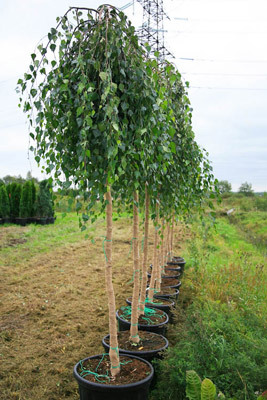 Drooping birch "Yungi"Betula pendula "Youngii"
- It features a tent-like, openwork crown with a white bark and shoots drooping to the ground. The tree is up to 5-9 meters tall, with a crown diameter of up to 4-6 meters. The shape of the crown is hip-shaped. The main branches are horizontally directed and curved, forming a picturesque, irregularly shaped crown with very thin branches hanging to the ground. The bark of the trunk and main branches is white, layered, at old trees at the base of the trunk it is replaced by deep-cracked, black, strong. The leaves are triangular or rhombic-ovate, 3-7 cm long., The edges are biconcostate, glabrous on both sides. Autumn color is yellow. The growth rate is average. Winter hardiness is high, in winter, freezing of annual shoots is possible. Photophilous. It is unpretentious to soils and moisture, grows equally well both in dry and in damp places. Recommended spring planting. Planting in places where trampling and strong compaction of the soil is possible is not recommended, since birch suffers from compaction of the soil. Propagated only by grafting on a standard, so the total height of the tree depends on the height at which the grafting is done. It is used as a tapeworm on the lawn, as an accent in tree-shrubbery and in groups mixed with perennials. Good for framing ponds. Warty birch "Aurea". This slow-growing tree up to 10 m high has very beautiful shiny golden yellow leaves. Their color is especially bright in spring and early summer, and later they become greenish-yellow. Has no autumn coloring. The flowers are yellow earrings that appear in May. Crohn's lace with flowing branches, white trunk. It grows quite slowly.
Drooping birch "Yungi"Betula pendula "Youngii"
- It features a tent-like, openwork crown with a white bark and shoots drooping to the ground. The tree is up to 5-9 meters tall, with a crown diameter of up to 4-6 meters. The shape of the crown is hip-shaped. The main branches are horizontally directed and curved, forming a picturesque, irregularly shaped crown with very thin branches hanging to the ground. The bark of the trunk and main branches is white, layered, at old trees at the base of the trunk it is replaced by deep-cracked, black, strong. The leaves are triangular or rhombic-ovate, 3-7 cm long., The edges are biconcostate, glabrous on both sides. Autumn color is yellow. The growth rate is average. Winter hardiness is high, in winter, freezing of annual shoots is possible. Photophilous. It is unpretentious to soils and moisture, grows equally well both in dry and in damp places. Recommended spring planting. Planting in places where trampling and strong compaction of the soil is possible is not recommended, since birch suffers from compaction of the soil. Propagated only by grafting on a standard, so the total height of the tree depends on the height at which the grafting is done. It is used as a tapeworm on the lawn, as an accent in tree-shrubbery and in groups mixed with perennials. Good for framing ponds. Warty birch "Aurea". This slow-growing tree up to 10 m high has very beautiful shiny golden yellow leaves. Their color is especially bright in spring and early summer, and later they become greenish-yellow. Has no autumn coloring. The flowers are yellow earrings that appear in May. Crohn's lace with flowing branches, white trunk. It grows quite slowly.
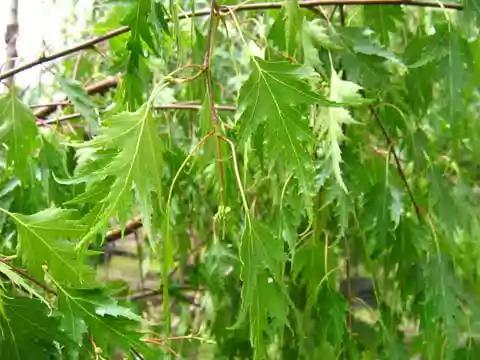 It features a weeping crown shape and deeply dissected leaves of light green color.A beautiful tree up to 6-8 meters high with a weeping, through-crowned crown and a lightly painted trunk. Leaves with uneven edges, deeply dissected. In youth, tarry, bright, light green, later - green, in the fall - with a smooth yellow color. Earrings are drooping, long. Growing fast.Winter hardiness is high. Very photophilous. Drought resistant. Little demanding on the richness of the soil. It does not tolerate soil compaction and thawing.Landing in well-lit places, preferably in the springtime, with autumn planting, a big drop occurs. It is not recommended to land in places where a large number of people can accumulate in order to avoid compaction and trampling of the soil.It is used for single and group plantings of the foreground, as well as for creating tree-shrubbery and mixed with perennial groups.
It features a weeping crown shape and deeply dissected leaves of light green color.A beautiful tree up to 6-8 meters high with a weeping, through-crowned crown and a lightly painted trunk. Leaves with uneven edges, deeply dissected. In youth, tarry, bright, light green, later - green, in the fall - with a smooth yellow color. Earrings are drooping, long. Growing fast.Winter hardiness is high. Very photophilous. Drought resistant. Little demanding on the richness of the soil. It does not tolerate soil compaction and thawing.Landing in well-lit places, preferably in the springtime, with autumn planting, a big drop occurs. It is not recommended to land in places where a large number of people can accumulate in order to avoid compaction and trampling of the soil.It is used for single and group plantings of the foreground, as well as for creating tree-shrubbery and mixed with perennial groups.
.
Hanging Birch “Fastigiata” \u003d Betula pendula “Fastigiata”
It differs in the columnar shape of the crown.In the winter state it looks particularly attractive thanks to fluffy vertically wave-shaped branches.Slender tree up to 10 -15 meters tall.Crohn at a young age is narrow pyramidal. In adulthood, wide-columned, more fluffy, blown, does not retain its vertical shape. The diameter of the crown reaches 5 meters wide.The bark of young trunks is white, exfoliates in thin layers. Later, the bark fades to dark gray. In the lower part of the trunk becomes rough-fissured and deeply furrowed black. All the main branches are strictly vertical and have a sharp angle from the trunk. The branches are unevenly wavy-twisted, in adult trees in the upper part of the crown hang down arcuately. Young branches are red-brown in color, partially beam-branched.The leaves are triangular-diamond-shaped, coarse, dark green, appear earlier than in Betula pendula.Autumn color of leaves is yellow, sometimes brown. Fall off late.Winter hardiness is high.Photophilous, but tolerates partial shade.It is unpretentious to soils and moisture, however, it does not tolerate close occurrence of groundwater. The root system is superficial.The seaside wind does not tolerate well.Spring landing on a permanent place is preferable, because it does not tolerate transplantation.Suffers from soil compaction.Formative pruning is possible at a young age.It is used to create group plantings, alleys, tree-shrub groups, field protection strips.
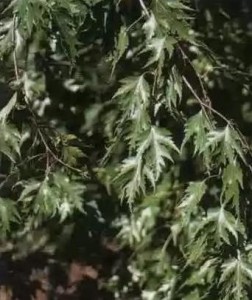 Warty birch "" Laciniata "\u003d Drooping birch" Laciniata "
- It features a weeping oval crown shape, a white trunk and heavily indented serrated leaves. A tree 10-12 meters high with an elegant, openwork, weeping crown. The shape of the crown is oval. The bark is white, smooth, in the lower part of the trunk black-gray, fissured. Young trees have brown bark. The leaves are strongly indented, with sharp serrated lobes, bright green in the summer and yellow in the fall. Growing fast. Winter hardiness is high, in severe winters annual shoots can freeze. Very photophilous. Soil fertility is not demanding, but grows better on fresh sandy loamy or loamy soils. It does not tolerate the proximity of groundwater. Not very resistant to gas and smoke. It does not tolerate soil compaction. Landing only in bright places. If planting is carried out by seedlings with an open root system, then it is better to carry out it in the early spring, as during the autumn planting there is a big drop. It is not recommended to plant in places where soil compaction is possible. Landing near motorways is not recommended. It is used for single and group plantings, the creation of tree-shrub groups together with rocks having dense and dark crowns.
Warty birch "" Laciniata "\u003d Drooping birch" Laciniata "
- It features a weeping oval crown shape, a white trunk and heavily indented serrated leaves. A tree 10-12 meters high with an elegant, openwork, weeping crown. The shape of the crown is oval. The bark is white, smooth, in the lower part of the trunk black-gray, fissured. Young trees have brown bark. The leaves are strongly indented, with sharp serrated lobes, bright green in the summer and yellow in the fall. Growing fast. Winter hardiness is high, in severe winters annual shoots can freeze. Very photophilous. Soil fertility is not demanding, but grows better on fresh sandy loamy or loamy soils. It does not tolerate the proximity of groundwater. Not very resistant to gas and smoke. It does not tolerate soil compaction. Landing only in bright places. If planting is carried out by seedlings with an open root system, then it is better to carry out it in the early spring, as during the autumn planting there is a big drop. It is not recommended to plant in places where soil compaction is possible. Landing near motorways is not recommended. It is used for single and group plantings, the creation of tree-shrub groups together with rocks having dense and dark crowns.
Location: prefers sunny or slightly shaded places, but there are also quite shade-tolerant (B. woolly, ribbed, yellow).
Landing: when planting, the distance between plants is not less than 3 - 4 m. The soil mixture consists of sheet soil, peat and sand (2: 1: 2). A drainage of sand with a layer of 15 cm is desirable. Planting is done in early spring at the age of no older than 5-7 years, more adults are planted in winter, with a frozen lump; during autumn planting, a large decline occurs.When planting birches, there is one very important mandatory rule - in no case can you deepen the root neck of a seedling. If it is at least slightly below the soil / the tree will suffer for several years, and then it will die anyway. The fact is that in this case mycorrhiza completely dies on birch roots, and birch cannot exist without its cohabitants, mushrooms. For the same reason, birch trees do not tolerate soil fillings over the roots of adult trees and increase the level of groundwater (the latter is less related to the originally bog species - fluffy birch, but it is rarely grown). Of course, in the early years, seedlings should be watered as necessary, but subsequently not only the majority of “black” birches are put up with temporary drought, but even a fluffy birch.But fertilizing the soil is worth considering, again, only in the case of “black” birches, very demanding of this. The best fertilizer will be the addition of sheet land directly during planting. Well, for white-stemmed birches, you don’t have to worry about this at all - everything you need will be delivered to these plants by symbiotic mushrooms.
Care: Top dressing. In the early spring, before the leaves appear, and at the end of spring, trees are fed: 1 kg of mullein, 10 g of urea, 15 g of ammonium nitrate are taken on a bucket of water. 10 - 20-year-old plants require 30 l of solution, in 30 and more years - 50 l.Mandatory watering during planting and three to four days after it.
Loosening, mulching.
The soil is loosened to a depth of 3 cm during weeding. Trunk circles are mulched with peat, peat compost, wood chips with a layer of 8-12 cm. Cutting, trimming. In the spring, dry branches are cut.
Protection against diseases and pests
. Pipe beetles damage young shoots and leaves. It is recommended that the affected leaves be collected and burned, and trunk trunks should be dug up. Caterpillars of the nun silkworm and corydalis bucephalus eat leaves leaving only veins. The caterpillars are shaken off, and the plants are treated with insecticides. May bugs and their larvae eat roots. It is recommended that the digging of the soil and the selection of Birch larvae are susceptible to many fungal diseases, fungus fungi, which destroy wood, are especially dangerous. They should be deleted. Anti-rust is sprayed with fungicides, for example copper chloride (0.4%).
Preparing for the winter. Barrel circles are covered in especially valuable decorative forms planted in autumn.
Using: are among the best park trees and are highly desirable in gardens and alleyways, but always on a strip of lawn. They are decorated with openwork crown, bright color of the bark, light green foliage in spring and golden yellow in autumn. Suitable for all types of plantings, especially in combination with mountain ash, willows, oaks, lindens, maples, beech, bird cherry, as well as on the background of conifers. When planting birches, one should take into account its proximity as a “whip”, especially birches with thin hanging branches, from which conifers especially suffer.
Partners: grass and plants are always better under a birch tree than under a fluffy one. In the latter, the crown is denser, the crowns of individual trees are in contact. But there are a number of plants, albeit not so many, that could be used under it. The limiting factors here are shadow and dryness. Among woody plants, one could use common hazel and its varieties, Kalinolistny vesiculata and its varieties, assorted snow-berries, some spirea (though to the detriment of plentiful flowering), tree-like karagan and its varieties, as a groundcover and winding on supports - a wood-cutter and a girl's five-leaf grapes are smaller than usual, but white dogwood and its varieties will grow there, some hawthorn and Tatar honeysuckle, hollow magonia and chubushniki (although not so plentifully flowering), good bushes, but not very about blooming, shrubby cinquefoil will give, it is good to use alpine currants and mountain ash in assortment, Chinese junipers, the forms and varieties of common spruce, thawed western and other plants. The list of perennials is even more. The limiting factor is the same - dry shadow. It’s good if they are not the most demanding of fertility.
Azalea /// Manchurian Apricot /// Amorpha shrubby /// Aralia Manchurian /// Chokeberry chokeberry /// Scarlet Japanese /// Barberry /// Amur Velvet /// /// Euonymus European Fortune /// Privet ordinary /// Anobiolacea bobovnik /// Hawthorn /// Buddley /// Elderberry black /// Elderberry Common /// Elderberry Canadian /// Weigela early /// Flowering weigela /// Gingko bilobate /// Hydrangea /// Panicle hydrangea /// Hydrangea gray /// Rough action /// Derain white /// Scion Derain /// English oak /// Red oak /// Honeysuckle Tatar /// White willow /// Willow fragile /// Willow red /// Willow basket /// Willow matsudina /// Purple willow /// Willow creeping /// Canadian Irga Kalina gorodina Common viburnum Karagana tree Catalpa bignoniform /// Horse Chestnut /// Keria Japanese /// Cotoneaster spread wide /// Cotoneaster horizontal /// Cotoneaster brilliant /// False Maple Maple /// Ginnala's Maple /// Sugar maple /// Tatar maple /// Silver maple /// Dune-shaped maple /// Red maple /// False maple /// Norway maple /// Field maple /// Ash maple /// Shrubby cinquefoil /// Hazel tree /// Common hazel /// Small-leaved linden /// Broad-leaved linden /// Narrow-leaved goof /// Silver goof /// Mugonia holly /// Three-bladed almonds /// Sea buckthorn /// Gray alder /// Walnut /// Butternut /// Manchurian Walnut /// Black walnut /// Holly /// Pachisandra apical /// Kalinolisty /// Robinia pseudoacacia /// Dog rose /// Rose gray /// Rose rugosa /// Femoral rose /// Wrinkled rose /// Rosa Rugotida /// Multi-flowered rose /// Mountain ash aria /// Mountain ash /// Mountain ash Turin /// Mountain ash round-leaved /// Rhododendron /// Mountain ash broadleaf /// Hungarian Lilac /// Lilac Preston /// Common lilac /// Tummy leather /// Snow White /// Spirea Varieties and Species /// Stefanandra incised /// Sumakh Olenerogy /// Pyramidal Poplar /// Black poplar /// Forsythia Medium /// Forsythia Intermediate /// Forsythia ovoid ///

